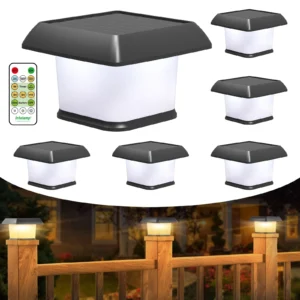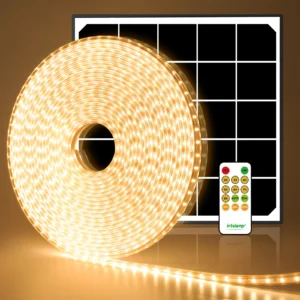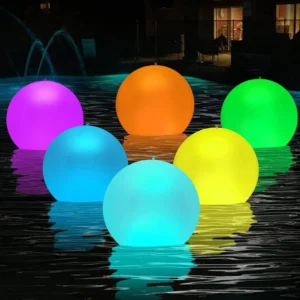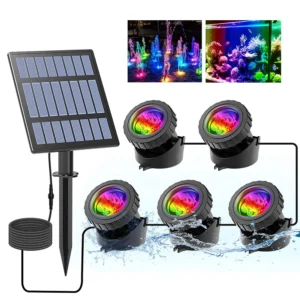When using solar lights, one of the key factors to consider is the placement of the solar panels. Most instruction manuals emphasize that solar panels should be positioned to receive direct sunlight. This is crucial for effective charging solar lights.
Challenges of Solar Lighting
While solar lights are a fantastic energy-efficient option for outdoor and indoor lighting, several challenges can affect their performance and reliability. Understanding these challenges is crucial for anyone considering solar lighting solutions.
1. Weather Dependence
Solar lights rely heavily on sunlight for charging, making them susceptible to weather conditions. Overcast days, rain, and winter months with shorter daylight hours can significantly reduce the amount of solar energy collected. During these times, solar lights may not charge fully, resulting in dimmer output or even complete failure to turn on at night.
2. Seasonal Variations
In addition to daily weather fluctuations, seasonal changes can impact solar light effectiveness. For instance, in winter, the sun’s angle is lower, resulting in reduced sunlight exposure. This can be particularly problematic in areas with heavy snowfall, where snow accumulation can block solar panels, further limiting their ability to capture sunlight.
3. Placement Issues
Finding the ideal placement for solar lights is essential but can be challenging. Trees, buildings, and other structures can cast shadows, blocking sunlight from reaching the solar panels. Poor placement can lead to insufficient charging and reduced functionality. Homeowners must strategically position their solar lights to maximize sun exposure throughout the day.
4. Battery Limitations
The performance of solar lights is also influenced by the quality and capacity of the batteries used. Over time, batteries can degrade, leading to shorter charging cycles and reduced overall efficiency. Understanding the battery specifications and regularly maintaining or replacing them is vital for long-term functionality.
5. Light Intensity and Duration
The intensity and duration of sunlight can vary significantly based on geographic location and time of year. In regions closer to the equator, solar lights may perform better year-round due to consistent sunlight. In contrast, areas with long winters or frequent cloudy weather may experience challenges in maintaining reliable solar lighting.
6. Initial Costs vs. Long-Term Savings
While solar lights can lead to significant savings on energy bills over time, the initial investment can be higher than traditional lighting solutions. This upfront cost can be a barrier for some consumers, despite the long-term benefits. It’s essential to consider both initial and ongoing costs when evaluating solar lighting options.
7. Maintenance Needs
Solar lights require minimal maintenance, but they are not entirely maintenance-free. Dust, dirt, and debris can accumulate on solar panels, hindering their ability to collect sunlight. Regular cleaning and inspection are necessary to ensure optimal performance. Additionally, any damage to the solar panel or the light fixture itself can compromise functionality.
Can You Charge Solar Lights with a Lamp?
The idea of charging solar lights with a regular lamp may seem convenient, especially on days with limited sunlight. However, there are several key factors to consider when evaluating this method of charging solar lights.
1. Light Intensity Comparison
One of the primary reasons charging solar lights with a lamp is ineffective is the significant difference in light intensity between sunlight and artificial lighting. Sunlight can deliver lux levels ranging from 32,000 to 100,000 lux on a bright day, whereas standard indoor lighting typically measures around 500 lux or less. This stark contrast means that the photons emitted by a lamp do not provide enough energy to effectively energize the solar panel and charge the battery.
2. Photovoltaic Effect Limitations
Solar panels are specifically designed to capture sunlight using the photovoltaic effect, where photons from the sun energize electrons in the solar cells, generating electricity. Regular lamps, whether incandescent or LED, do not emit the same spectrum or intensity of light needed for this process. The wavelengths of light produced by these lamps are not optimized for solar panel efficiency, making it challenging to generate the necessary electric current.
3. Duration of Charging
Even if it were possible to charge solar lights with a lamp, the time required to achieve a full charge would be significantly longer than using sunlight. A standard desk lamp may take several hours or even days to provide enough energy to charge a solar light adequately. This impracticality can lead to frustration and inconvenience, as users may find themselves waiting indefinitely for a charge that would typically take only a few hours of direct sunlight.
4. Battery Performance and Lifespan
Charging solar lights with inadequate light sources can negatively impact battery performance and lifespan. If the battery does not receive sufficient energy, it may not charge fully, leading to diminished output during the night. Over time, consistently low charging levels can cause the battery to degrade faster, reducing its overall efficiency and longevity.
5. Alternative Solutions for Indoor Charging
If you’re considering solar lights for indoor use, there are more effective alternatives. Some solar lights come with external solar panels that can be placed in direct sunlight while the light fixture itself remains indoors. This setup allows the solar panel to gather sunlight efficiently, providing the necessary charge for the light.
6. Recommendations for Charging
To optimize the performance of solar lights, it is best to ensure they are placed in areas where they can receive maximum sunlight exposure throughout the day. If indoor solar lighting is desired, look for products specifically designed for that purpose, which can incorporate features such as movable solar panels.
How Solar Energy Works
Understanding how solar energy works is essential for anyone interested in harnessing this renewable resource for lighting and other applications. The process involves several key steps, from capturing sunlight to converting it into usable electricity. Here’s a detailed breakdown of how solar energy is transformed into electrical power:
1. The Photovoltaic Effect
At the core of solar energy conversion is the photovoltaic (PV) effect. This phenomenon occurs in solar cells, which are typically made from semiconductor materials like silicon. When sunlight, composed of particles called photons, strikes the surface of a solar panel, it energizes the electrons in the semiconductor material. Here’s how it works:
- Photon Absorption: When photons hit the solar cell, their energy is absorbed by the semiconductor material.
- Electron Excitation: This absorbed energy excites electrons, freeing them from their atomic bonds and creating free electrons and “holes” (the absence of an electron).
- Electric Current Generation: The movement of these free electrons creates a flow of electric current. The design of solar cells includes built-in electric fields that direct these electrons toward conductive metal plates, leading to the formation of usable electricity.
2. Solar Panel Composition
Solar panels are made up of multiple solar cells connected together. The cells are typically arranged in layers:
- Front Layer: A thin layer of transparent material (like glass) protects the cells while allowing sunlight to pass through.
- Anti-Reflective Coating: This coating minimizes the reflection of sunlight, ensuring more photons are absorbed by the cells.
- Silicon Layers: Most solar cells consist of two layers of silicon, one positively charged (p-type) and one negatively charged (n-type). This p-n junction is crucial for creating an electric field that drives electron flow.
3. Conversion to Usable Energy
Once the solar panels generate electricity, the next step is converting this direct current (DC) into alternating current (AC), which is the standard form of electricity used in homes and businesses. This conversion is done through an inverter, which plays a critical role in solar energy systems:
- Inverter Functionality: The inverter transforms the DC electricity produced by the solar panels into AC electricity. This makes it compatible with the electrical grid and household appliances.
- Energy Storage: In addition to direct use, solar energy can also be stored in batteries for later use, particularly during nighttime or cloudy days when sunlight is not available. Advanced battery systems ensure that excess energy generated during the day can be utilized when needed.
4. Integration with the Electrical Grid
Solar energy systems can operate independently or be connected to the electrical grid. When connected to the grid:
- Net Metering: Homeowners can sell excess electricity generated back to the grid, often through a system known as net metering. This allows for credits on their utility bills, making solar energy not only sustainable but also economically beneficial.
- Energy Independence: In areas with unstable power supplies, solar energy can provide a reliable source of electricity, enhancing energy independence.
5. Environmental Impact
Solar energy is a clean and renewable resource, contributing to a reduction in greenhouse gas emissions compared to fossil fuels. By utilizing solar power, individuals and businesses can lower their carbon footprint and promote environmental sustainability.
6. Innovations in Solar Technology
The field of solar energy is continually evolving with advancements in technology. Innovations include:
- Bifacial Solar Panels: These panels can capture sunlight from both sides, increasing efficiency.
- Thin-Film Solar Cells: These are lightweight and flexible, allowing for new applications and easier installations.
- Building-Integrated Photovoltaics (BIPV): Solar technology is being integrated into building materials, such as windows and roofs, allowing for aesthetic and functional benefits.
Light Intensity Measurement
Measuring light intensity is crucial for understanding how effectively solar panels, including solar lights, can capture and convert sunlight into electricity. Light intensity impacts the performance of solar devices, making it essential to comprehend the concepts and tools involved in light measurement. Here’s an in-depth look at how light intensity is measured and its significance in solar energy applications.
1. Key Terms: Lux and Lumens
To measure light intensity accurately, two primary units are commonly used: lux and lumens. Each plays a distinct role in understanding how light interacts with solar panels.
Lux: Lux is the metric unit of illuminance, representing the amount of light that falls on a given surface area. One lux is defined as one lumen per square meter. Lux measurements are essential for determining how much usable light is available for solar panels and solar lights. For example, a bright sunny day can yield light levels of 32,000 to 100,000 lux, while indoor lighting typically ranges from 100 to 1,000 lux.
Lumens: Lumens measure the total amount of visible light emitted by a light source per unit of time. Unlike lux, which takes into account the area over which the light is distributed, lumens focus solely on the quantity of light produced. Understanding lumens helps in comparing different light sources, including bulbs and solar lights.
The Relation Between Lux and Lumen: The relationship between lux and lumen can be expressed as: Lux = Lumen / Area. Essentially, the greater the lux level, the more photons are available to energize electrons in the solar panel, leading to higher current generation and faster charging.
2. Measuring Light Intensity
There are several methods and tools used to measure light intensity, ensuring accurate data for solar energy applications:
Light Meters: A light meter is an essential tool for measuring light intensity. These devices can provide readings in lux or foot-candles (another unit of illuminance used primarily in the U.S.). Light meters can help determine the optimal placement for solar panels by measuring the intensity of light in various locations.
Smartphone Apps: Many smartphone applications utilize the phone’s camera sensor to measure light intensity. While these apps may not be as precise as dedicated light meters, they can still provide useful estimates for casual assessments.
Spectrometers: For advanced analysis, spectrometers measure the intensity of light at different wavelengths, providing insights into the spectral quality of light. This information can be crucial for understanding how effectively solar panels can convert light into electricity based on its wavelength.
3. Factors Affecting Light Intensity Measurements
Several factors can influence light intensity readings, which are important to consider when evaluating solar energy systems:
Time of Day: Light intensity varies throughout the day. Morning and evening light is typically less intense compared to midday sun. For solar panels, positioning them to capture peak sunlight hours (usually between 10 a.m. and 2 p.m.) can maximize energy production.
Weather Conditions: Cloud cover, fog, and atmospheric conditions can significantly reduce light intensity. Overcast days may lead to a substantial drop in lux levels, affecting solar charging efficiency.
Surface Reflections: Different surfaces can reflect light differently, affecting the amount of light available for solar panels. For instance, sandy or white surfaces may reflect more light than dark surfaces, which can enhance solar energy capture.
Shading: Objects such as trees, buildings, or even dirt accumulation on solar panels can cast shadows, reducing the effective light intensity that reaches the solar cells.
4. Importance of Light Intensity Measurement for Solar Panels
Understanding light intensity is critical for optimizing solar energy systems:
Maximizing Efficiency: By measuring light intensity at potential installation sites, users can identify locations that receive the most sunlight, leading to better energy production from solar panels.
Performance Monitoring: Regularly monitoring light intensity helps assess the performance of solar systems over time. If light levels drop unexpectedly, it may indicate issues such as shading or dirt accumulation on solar panels that require attention.
System Design and Planning: Knowledge of local light intensity patterns can aid in designing solar energy systems that are tailored to specific geographic and climatic conditions, ensuring maximum efficiency and output.
Lux Levels in Different Conditions
Understanding lux levels in various lighting conditions is essential for optimizing solar energy systems, including solar lights and panels. Lux, as a measure of illuminance, helps assess how much usable light is available for solar energy conversion. Here’s an exploration of lux levels in different environments, highlighting how these variations affect solar performance.
1. Natural Light Conditions
Natural sunlight provides the most significant source of light intensity, varying greatly throughout the day and under different weather conditions:
Direct Sunlight: On a clear, sunny day, lux levels can range from 32,000 to 100,000 lux. This high intensity is optimal for solar panels, allowing for maximum energy absorption and efficient operation. The direct sunlight is crucial for solar lights to function effectively.
Partially Cloudy: During partly cloudy conditions, lux levels typically drop to around 1,000 to 10,000 lux. While solar panels can still generate energy in this light, the output will be significantly reduced compared to sunny days.
Overcast Days: On cloudy or rainy days, lux levels can decrease to about 100 to 1,000 lux. In these conditions, solar panels may struggle to charge adequately, and solar lights may not operate at full capacity. However, they can still harness some energy, albeit much less than on sunnier days.
Dusk and Dawn: During sunrise and sunset, lux levels can range from 100 to 400 lux. Although these levels are lower, solar lights can still operate if they have been charged adequately throughout the day.
2. Indoor Light Conditions
Indoor lighting presents a different set of challenges for solar energy systems, particularly solar lights:
Standard Office Lighting: Typical office environments emit about 300 to 500 lux. While this level can support some energy generation, it is insufficient for effectively charging solar lights. Indoor solar lights designed for use in such conditions must be equipped with powerful batteries to compensate for the lower light levels.
Dim Lighting: Areas with lower light levels, such as those illuminated by small lamps or ambient lighting, can register as low as 100 lux or less. Under these conditions, solar lights will not charge efficiently, limiting their usability without direct sunlight.
Bright Indoor Lighting: Specialized indoor lighting, such as that from high-output LEDs, can reach 1,000 lux or more. While these levels are more conducive to solar charging, they still fall short of outdoor sunlight’s intensity, making solar lights less effective.
3. Artificial Light Sources
Artificial light sources vary in brightness and spectrum, affecting their ability to charge solar panels effectively:
Incandescent Bulbs: These bulbs typically produce around 10 to 20 lumens per watt, translating to lower lux levels. They are generally not effective for charging solar lights, as their light intensity is much weaker than sunlight.
Fluorescent Lights: Fluorescent fixtures can emit between 30 to 60 lumens per watt, which translates to moderate lux levels. While they can provide some illumination, the intensity is still far below that of sunlight.
LED Lighting: LED lights are highly efficient and can generate high lux levels (up to 1000 lux or more) while consuming less energy. Some advanced solar lights can utilize LED lighting for charging, but efficiency remains limited compared to natural sunlight.
4. Shading Effects
Shading can drastically affect the lux levels received by solar panels:
Shadowed Areas: Even partial shading from trees, buildings, or other obstacles can reduce lux levels significantly, sometimes dropping below 100 lux. This can inhibit solar charging and impact the performance of solar lights.
Reflected Light: Light reflecting off surfaces like water, snow, or sandy areas can enhance lux levels, allowing for improved solar energy capture. For instance, areas near water bodies can experience increased lux due to reflection.
5. Seasonal Variations
Lux levels also fluctuate with the seasons:
Summer: Longer daylight hours and more direct sunlight result in higher lux levels, providing optimal conditions for solar energy systems.
Winter: Shorter days and lower sun angles can reduce lux levels significantly, often leading to inadequate charging for solar lights and panels.
Conclusion
Returning to the original question, can you charge solar lights with a lamp? Based on the lux data, direct sunlight offers lux levels between 32,000 and 100,000, whereas standard indoor lighting typically measures around 500 lux. Therefore, while you could technically charge a solar light with a desk lamp, the process would be extremely slow and inefficient.
Additionally, solar lights do not perform well in shaded areas, where lux levels are often lower than those of direct sunlight. For indoor use, solar lights with built-in solar panels require direct sunlight exposure, while those with external solar panels can be positioned to charge effectively indoors, such as on a patio or balcony.
Finally, the time needed to charge solar lights varies based on battery capacity and light intensity. Larger solar panels can capture more photons, reducing charging time. To maximize efficiency, always ensure your solar panels are placed in direct sunlight.


















